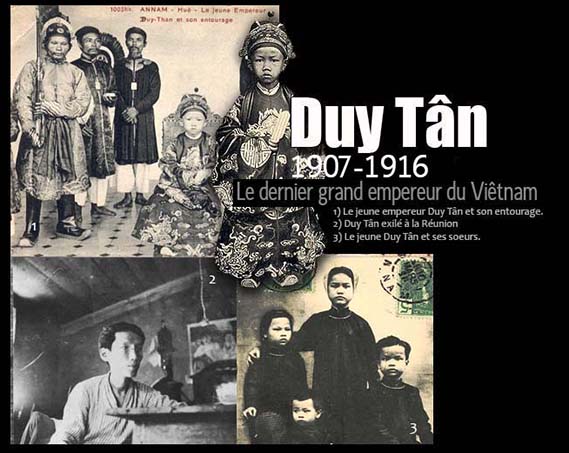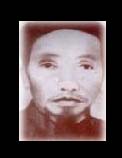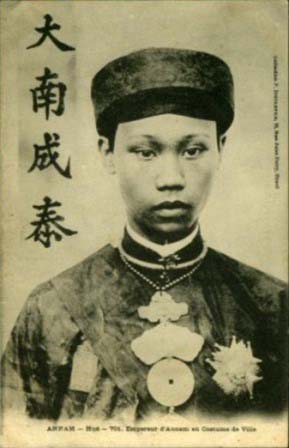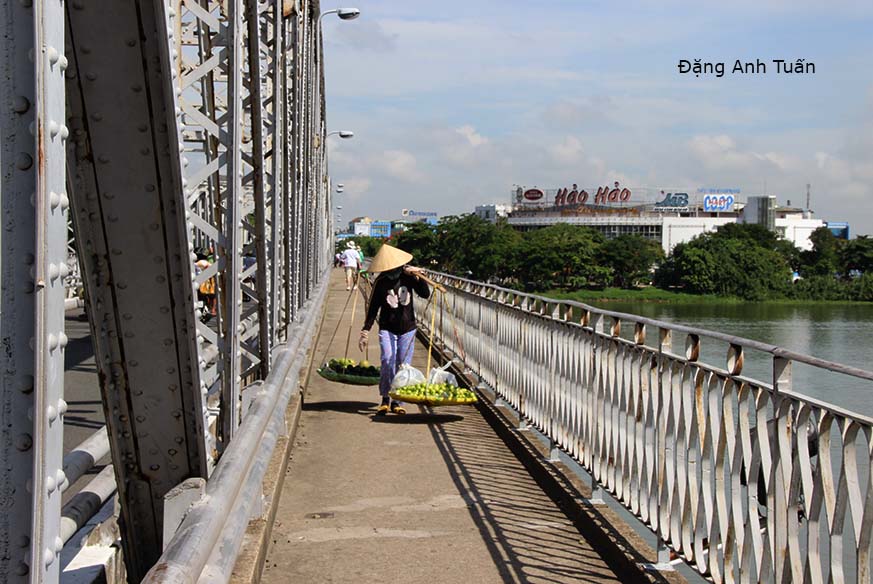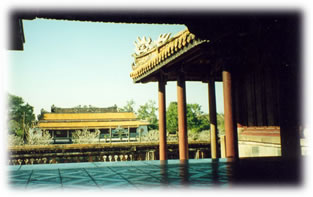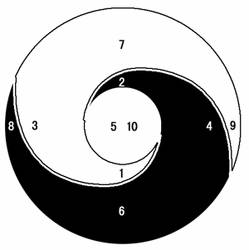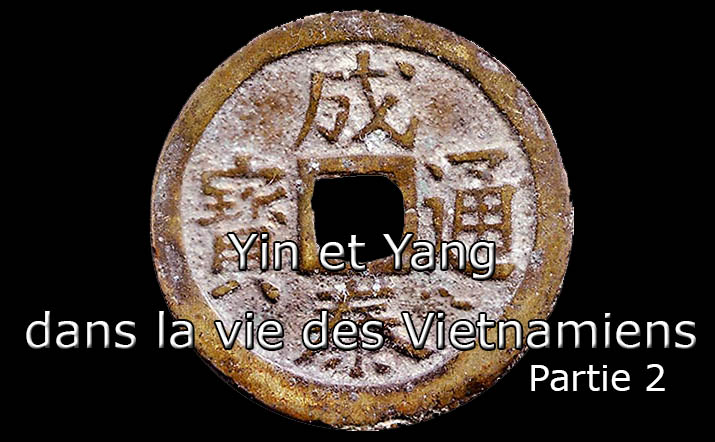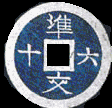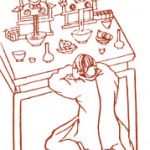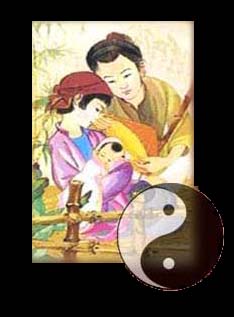Version française
Mois : mars 2018
Duy Tân (1907-1916) (English version)
A great homage to the man who has dedicated all his life for his people and his country.
Một đời vì nước vì dân
Vĩnh San đứa trẻ không cần ngôi vua
Tù đày tử nhục khi thua
Tử rồi khí phách ông vua muôn đời
With the agreement of the Vietnamese authorities, the ashes of emperor Duy Tân interred up to now in the Republic of Central Africa were gathered with great pomp on April 4th, 1987 in Huế, the city of imperial mausoleums of the Nguyen dynasty. This has brought an end to a long and painful banishment that has had prince Vĩnh San often known as Duy Tân ( or Friend of Reforms ) since his uprising plan against the colonial authorities was discovered on May 4, 1916 because of the treason of a collaborator, Nguyễn Ðình Trứ.
Duy Tân is an outstanding character that none of the last emperors of the Nguyễn dynasty could be equal to. One can only regret his sudden disappearance due to a plane crash that took place at the end of 1945 on his way back from a mission from Vietnam. His death continues to feed doubt and remains one of the mysteries not elucidated until today. One found in him at that time not only the unequal popularity he knew how to acquire from his people, the royal legitimacy, but also an undeniable francophile, an alternative solution that general De Gaulle contemplated to propose to the Vietnamese at the last moment to counter the young revolutionary Hồ Chí Minh in Indochina. If he had been alive, Vietnam probably would not have known the ill-fated decades of its history and been the victim of the East-West confrontation and the cold war.
It is a profound regret that every Vietnamese could only feel when talking about him, his life and his fate. It is also a misfortune for the Vietnamese people to have lost a great statesman, to have written their history with blood and tears during the last decades.
His ascension to the throne remains a unique occurrence in the Annals of history of Vietnam. Taking advantage of suspicious anti-french schemes and the disguised lunacy of his father, emperor Thành Thái, the colonial authorities compelled the latter to abdicate in 1907 and go into exile in the Reunion at the age of 28. They requested that Prime Minister Trương Như Cường assume the regency. However this one while categorically refusing this proposal, kept demanding the colonial authorities to strictly respect the definite agreement in the Patenôtre Treaty of Protectorate (1884) providing that the throne comes back to one of the emperor’s sons in case he ceases reigning ( Phụ truyền tử kế ). Facing popular opinion and the infallible fidelity of Trương Như Cương to the Nguyen dynasty, the colonial authorities were forced to choose one of his sons as emperor. They did not hide their intention of choosing the one that seemed docile and without caliber. Except Vĩnh San, all of about 20 other sons of emperor Thành Thái were present at the moment of selection made by the General Resident Sylvain Levecque. The name Vĩnh San missed at the roll-call, which forced everyone to look for him everywhere.
Finally he was found under the beam of a frame, his face covered with mud and soak with sweat. He was chasing the crickets. Seeing him in this sordid condition, Sylvain Levecque did not hide his satisfaction because he thought only a fool would choose the day of ascession to the throne to go chasing the crickets. Upon the recommendation of his close collaborator Charles, he decided to designate him as emperor of Annam as he found in front of him a seven-year old child, timid, reserved, having no political ambition and thinking only to devote himself to games like children of his age. It was an erroneous judgment as stated in the comment of a French journalist at that time in his local newspaper:
A day on the throne has completely changed the face of an eight-year old child.
One noticed a few years later that the journalist was right because Duy Tân has dedicated all his life for his people and his country until his last breath of life.
At the time of his ascension to the throne he was only 7. To give him a stature of an emperor, they had to give him one more year of age. That is why in the Annals of history of Vietnam, he was brought to the throne at 8 years of age. To deal with this erroneous designation, the colonial authorities installed a council of regency constituted of Vietnamese personalities close to General Resident Sylvain Levecque ( Tôn Thất Hân, Nguyễn Hữu Bài, Huỳnh Côn, Miên Lịch, Lê Trinh, Cao Xuân Dục) to assist the emperor in the management of the country and requested that Eberhard, the father-in-law of Charles be Duy Tân’s tutor. It was a way to closely supervise the activities of this young man.
In spite of that, Duy Tân succeeded in evading the surveillance network placed by the colonial authorities. He was one of the fierce partisans for the revision of the Patenotre agreements (1884). He was the architect of several reforms: Tax and chore duty reduction, elimination of wasteful court protocols, reduction of his own salary etc… He forcefully protested the profanation of emperor Tự Ðức’s tomb by General Resident Mahé in his search for gold, with the governor of Indochina Albert Sarraut. He claimed the right to look at the management of the country. This marked the prelude of dissension which grew more and more visible between him and the French Superior Resident. On May 4, 1916, with Trần Cao Vân and Thái Phiên, he fomented a rebellion which was discovered and put down due to the treason of one of his collaborators. Despite his capture and flattering advice of the Governor of Indochina asking him to reexamine his comportment and conduct, he continued be impassible and said:
If you compelled me to remain emperor of Annam, you should consider me as an adult emperor. I should need neither the council of regency nor your advice. I should manage the country’s business on the same footing with all foreign countries including France.
Facing his unwavering conviction, the colonial authorities had to assign the Minister of Instructions of that time, the father-in-law of future emperor Khải-Ðịnh, Hồ Ðắc Trung to institute proceedings against his treason toward France. For not compromising Duy Tân, the two older collaborators Trần Cao Vân and Thái Phiên made it known to Hồ Đắc Trung their intent to voluntarily accept the verdict provided that emperor Duy Tân was exempt from the capital punishment. They kept saying:
The sky is still there. So are the earth and the dynasty. We wish long live to the emperor.
Faithful to the Nguyen dynasty, Hồ Ðắc Trung only condemned the emperor to exile in justifying the fact that he was a minor and that the responsibility of the plot rested with the older collaborators Trần Cao Vân and Thái Phiên.
The men were guillotined at An Hoà. As for emperor Duy Tân, he was condemned to exile to the Reunion on November 3, 1916 on board of the steamship Avardiana. The day before his departure, the representative of the General Resident visited him and asked:
Sir, if you need money you may take it from the state coffer.
Duy Tân replied politely :
The money that you find in the coffer is intended to help the king to govern the country but it does not belong to me in anyway especially to a political prisoner.
To entertain the king, the representative did not hesitate to remind him that it was possible to choose preferred books in the library and take them with him during his exile because he knew the king loved to read very much. He agreed to that proposal and told him:
I love reading very much. If you have the chance to bring books for me, don’t forget to bring the entirety of all the volumes of « History of the French Revolution » of Michelet.
The representative dared not report to the Resident what Duy Tan had told him.
His exile marked not only the end of the imperial resistance and the struggle monopolized and animated up until then by the scholars for the defense of the Confucian order and the imperial state but also the beginning of a national movement and the emergence of a state nationalism placed in birth by the great patriot scholar Phan Bội Châu. It was also a lost chance for France for not taking the initiative to give freedom to Vietnam in the person of Duy Tân, a francophile of the first hour.
His destiny is that of the Vietnamese people. For a certain time, one has deliberately made all streets bearing his name disappear in big cities ( Hànội, Huế, Sàigon ) in Vietnam, but one cannot forever erase his cherished name in his people’s heart and in our collective memory. He is not the rival of anybody but he is on the contrary
the last great emperor of Viet Nam.
To this title I dedicate to him the following four verses:
Devoting his whole life to his country and people,
Duy Tan the kid did not hang on to his throne.
Facing exile and humility when defeated,
His uprightness lives forever in history unabated.
Thành Thái (1879-1954) (English version)
A great homage to a man who devoted his whole life for his country and people through my Six-Eight verses:
Ta điên vì nước vì dân
Ta nào câm điếc một lần lên ngôi
Trăm ngàn tủi nhục thế thôi
Lưu đày thể xác than ôi cũng đành
His madness for the love of his country and people.
I am mad for the love of my country and people
Once on the throne, I can’t stay deaf-mute
It wouldn’t matter I feel self pity and shame
And my body suffers years of exile with resignation
Prior to becoming emperor Thành Thái, he was known as Bửu Lân. He was the son of emperor Dục Ðức who had been vilely assassinated by the two Confucianist mandarins Tôn Thất Thuyết and Nguyễn Văn Tường, and the grand son of the mandarin Phan Ðình Bình. Because the latter was maladroitly opposed to the enthronement of emperor Ðồng Khánh by the colonial authorities, Ðồng Khánh was fast to take revenge by cowardly getting rid of this old mandarin and by putting Bửu Lân and his mother under house surveillance within the surrounding wall of the purple city at the Trần Võ palace in order to avoid all seeds of revolt. That was why at Ðồng Khánh’s death and upon the announcement of the choice of her son as the successor by the colonial authorities, Buu Lan’s mother was surprised and cried so much because she was always obsessed by the idea that her son would probably meet the same fate as her husband, emperor Dục Đức and her father, the mandarin Phan Ðình Bình. If Buu Lan was preferred to other princes, it was incontestably due to the ingenuities of Diệp Văn Cương, the presumed lover of his aunt, princess Công Nữ Thiên Niệm because Diệp Vân Cương was Resident General Rheinart‘s personal secretary, in charge of conducting business with the Imperial Court to find a compromise on the person to be chosen to succeed emperor Ðồng Khánh.
Thus he involuntarily became our new emperor known as Thành Thái. He was fast to realize that his power was very limited, that the Patenôtre treaty was never respected and that he had no right with regard to the management and future of his country. Contrary to his predecessor Ðồng Khánh, close to the colonial authorities, he took a passive resistance by trying to thwart their policies in a systematic manner with his provoking remarks and amicable gestures. His fist virulent altercation with the Resident General Alexis Auvergne was noticed at the inaugural ceremony of the new bridge spanning across the Perfume river. Proud of technical prowess and confident of the sturdiness of the bridge, Alexis Auvergne did not hesitate to tell Thành Thái with his habitual cynicism:
When you would have seen this bridge collapse, your country would be independent.
To show the importance that the colonial authorities has given to the new bridge, they named it « Thành Thái ». This made the emperor mad. Using as a pretext that everyone can walk over his head when crossing the bridge, he forbade his subjects to call the bridge by its new name and incited them to use the old name « Tràng Tiền ».
Some years later, the bridge collapsed during a violent storm. Thành Thái was fast to recall Alexis Auvergne of what he had said with his black humor. Alexis Auvergne was red with shame and had to clear off at these embarrassing remarks. The dissension with the authorities grew day by day until the replacement of the old Resident General by Sylvain Levecque. The latter was fast to place a network of strict surveillance when he learned that Thanh Thai continued to approach his people through the bias of his reforms and his disguise in plain clothes or as a beggar in villages. He was the first emperor of Vietnam to take the initiative of having his hair cut the European fashion, which astonished so many of his mandarins and subjects when he first appeared. But he also was the first emperor to encourage his subjects to follow French education. He was the artisan of several architectural projects. He was also the first emperor of the Nguyen dynasty who wanted to pay enormous attention to the daily life of his subjects and to know their daily difficulties. It was reported that during an escorted excursion, he met on his way a poor man who was hauling a heavy load of bamboo. He body guard wanted to ease the way but he stopped him by saying:
I am neither citizen nor emperor as I should be in this country. Why do you chase him away?
During his excursions, he often used to sit on a mat, surrounded by the villagers and to discuss all the issues with them. It was in one of his excursion that he brought back to the purple city an oarswoman who accepted to marry him and became his concubine. He was well known as an excellent drummer.
That is why he summoned all the best drummers in the country to the purple city, asked them to play drums before his court and reward them generously according to their merit. It was reported that one day, he met a drummer who used to tilt his head when playing. Wanting to help him correct this funny habit, he told him jokingly:
If you keep on playing that way, I will have to have your head rolled.
From then on, the drummer, worrying incessantly about the next call, was overwhelmed by fear and died of a heart attack. One day, knowing the death of the drummer, Thanh Thai was taken my remorse, summoned his family and gave them a large sum of money to take care of their daily needs.
His way of joking, his frequent disguises, his sometimes strange behavior incomprehensible to the colonial authorities gave them an opportunity to brand him a lunatic.
As for Thành Thái, he was deported first to Vũng Tàu (former Cap St. Jacques) in the Fall of 1907, then later to the Reunion Island with his son, emperor Duy Tân in 1916. He was only allowed to return to Vietnam in 1945 after the death of Duy Tân and to stay confined within Vũng Tàu, South Vietnam during the last years of his life.
Is it possible to brand him lunatic when it is known through his poem titled « Hoài Cổ » (Remember the Past) that Thành Thái was so lucid and never stopped to groan with the pain facing the alarming situation of his country? Other eight seven-foot verses we know such as The storm of the year of the Dragon in 1904 ( Vịnh Trần Bão Năm Thìn ) or Profession of Faith (Cảm Hoài) not only show Thành Thai’s perfect mastery in the strict application of the difficult rules in Vietnamese poetry but also the painful pride of a great emperor who, in spite of a forced exile for almost half a century ( 1907-1954 ) by the colonial authorities, continued to display his conviction and unshakable faith in the liberation of his country. Through him it is already seen forging on this land of legends the instruments of a future revolt.
For him, his incurable illness was the goal to realize his intention, to give his people the dignity so long waited and to show future generations the sacrifice and the price which even he, a person considered alienated by the colonial authorities, had to pay for that country (47 years of exile). In the political context of the time, he should not reveal himself of this « illness ».
Up to now, no historic document show us Thành Thái’s insanity but rather it reveals a great emperor’s lunacy of the love of his country and people, never ending affliction of a great patriot facing the destiny of his country.
Yin and Yang numbers (Âm Dương: Part 3)
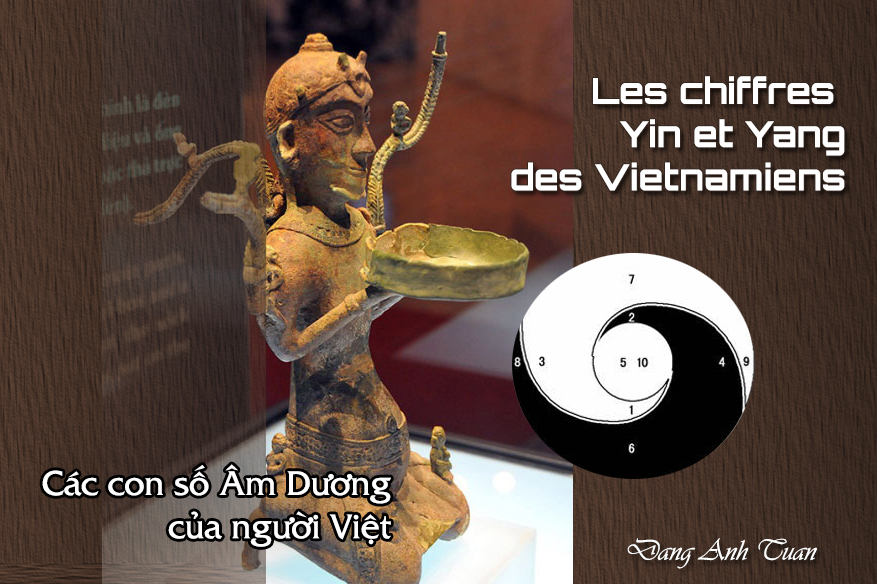
Yin and Yang numbers (Con số Âm Dương)
We are used to saying in Vietnamese: sống chết đều có số cả (Everyone has their D-day for life as well as for death). Ði buôn có số, ăn cỗ có phần (One has their vocation for trade just as one has their share at a feast). In everyday life, everyone has their size for clothes and shoes. It is noticed that, unlike the Chinese who adore even numbers, the Vietnamese rather favor odd numbers (số âm) over even numbers (số dương).
The frequent use of odd numbers is found in Vietnamese expressions: ba mặt một lời (One needs to be face to face in the presence of a witness), ba hồn bảy vía (three souls and seven vital supports for humans, i.e., one is panicked), Ba chìm bảy nổi chín lênh đênh (very turbulent), năm thê bảy thiếp (having 5 wives and 7 concubines, i.e., having multiple wives), năm lần bảy lượt (several times), năm cha ba mẹ (heterogeneous), ba chóp bảy nhoáng (hastily and carelessly), Một lời nói dối, sám hối 7 ngày (A lying word equals seven days of repentance), Một câu nhịn chín câu lành (Avoiding one offensive phrase is like having nine kind phrases), etc. or those involving multiples of the number 9: 18 (9×2) đời Hùng Vương (18 legendary Hùng Vương kings), 27 (9×3) đại tang 3 năm (27 months) (or a mourning period of three years which actually translates to only 27 months), 36 (9×4) phố phường Hà Nội (Hanoi with 36 districts), etc.
We must also not forget to mention the numbers 5 and 9, each having a very important role. The number 5 is the most mysterious number because everything begins from this number. Heaven and Earth have the 5 elements or agents (Ngũ hành) that give birth to all things and beings. It is placed at the center of the River Map (Hà Đồ) and the Luo River Writing (Lạc thư), which form the basis of the transformation of the 5 elements (Thủy, Hỏa, Mộc, Kim, Thổ) (Water, Fire, Wood, Metal, and Earth).
It is associated with the Earth element in the central position, which the farmer needs to know the direction of the cardinal points. This thus returns to man the center in managing things, species, and the four cardinal points. For this reason, in feudal society, this place was reserved for the king because he was the one who governed the people. Consequently, the number 5 belonged to him, as did the color yellow symbolizing the Earth. This explains the color chosen by Vietnamese and Chinese emperors for their garments.
Besides the center occupied by man, a symbolic animal is associated with each of the four cardinal points: the North by the turtle, the South by the phoenix, the East by the tiger, and the West by the dragon. It is not surprising to find at least in this attribution the three animals living in a region where agricultural life plays a significant role and water is vital.
Ho Tou Lo Chou
(Hà Đồ Lạc Thư)
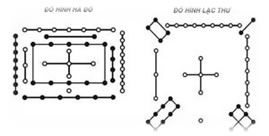
This is the territory of the Bai Yue. Even a dragon, so fierce in other cultures, becomes a gentle and noble animal imagined by the peaceful peoples of the Bai Yue. The number 5 is also known as « Tham Thiên Lưỡng Đia » (or ba Trời hai Ðất or 3 Yang 2 Yin) in the theory of Yin and Yang because obtaining the number 5 from the combination of the numbers 3 and 2 corresponds better to the reasonable percentage of Yin and Yang than that resulting from the combination of the numbers 4 and 1.
In the latter, one notices that the Yang number 1 is greatly dominated by the Yin number 4. This is not the case with the combination of numbers 3 and 2, where the Yang number 3 slightly dominates the (Yin) number 2. This favors the development of the universe in an almost perfect harmony. In the past, the fifth day, the fourteenth day (1+4=5), and the twenty-third day (2+3=5) of the month were reserved for the king’s outings. It was forbidden for subjects to conduct business during his travels and to disturb his walk. This may be the reason why many Vietnamese today, influenced by this ancestral tradition, continue to avoid choosing these days for building houses, traveling, and making important purchases. It is customary to say in Vietnamese:
Chớ đi ngày bảy chớ về ngày ba
Mồng năm, mười bốn hai ba
Đi chơi cũng lỗ nữa là đi buôn
Mồng năm mười bốn hai ba
Trồng cây cây đỗ, làm nhà nhà xiêu
Do not go on the seventh day, do not return on the third day
The fifth, fourteenth, twenty-third
Going out is also a loss, let alone trading
The fifth, fourteenth, twenty-third
Planting trees, the trees fail; building houses, the houses collapse.
You should avoid leaving on the 7th day and returning on the 3rd day of the month. On the 5th, 14th, and 23rd days of the month, you would be at a loss if you go out or do business. Similarly, you would see the fall of a tree or the tilting of your house if you plant it or build it on those days.
The number 5 is frequently mentioned in Vietnamese culinary art. The most typical sauce of the Vietnamese remains fish sauce. In the preparation of this national sauce, there are 5 flavors classified according to the 5 elements of Yin and Yang: salty (mặn) with fish juice (nước mắm), bitter (đắng) with lemon zest (vỏ chanh), sour (chua) with lemon juice (or vinegar), spicy (cay) with crushed or powdered chili peppers, and sweet (ngọt) with powdered sugar. These five flavors (mặn, đắng, chua, cay, ngọt) combined and found in the Vietnamese national sauce correspond respectively to the 5 elements defined in the Yin and Yang theory (Thủy, Hỏa, Mộc, Kim, Thổ) (Water, Fire, Wood, Metal, and Earth).
Similarly, these 5 flavors are found in the sweet and sour soup (canh chua) prepared with fish: sour with tamarind seeds or vinegar, sweet with pineapple slices, spicy with sliced chili peppers, salty with fish sauce, and bitter with some okra (đậu bắp) or with the flowers of the fayotier (bông so đũa). When this soup is served, a few fragrant herbs are added, such as panicaut (ngò gai), rau om (an herb with a flavor close to coriander but with an additional lemony note). This is a characteristic feature of the sweet and sour soup of Southern Vietnam and different from those found in other regions of Vietnam.
We cannot forget to mention the glutinous rice cake that the Proto-Vietnamese succeeded in passing down to their descendants over the millennia of their civilization. This cake is tangible proof of the belonging of the Yin and Yang theory and its five elements to the Hundred Yue, of which the Proto-Vietnamese were a part, because in the making of this cake, the generative cycle of these 5 elements (Ngũ hành tương sinh) found.
(Fire->Earth->Metal->Water->Wood)
Inside the cake, one finds a piece of porkmeat in red color ( Fire ) around which there is a kind of paste made with broad beans in yellow color ( Earth ). The whole thing is wrapped by the sticky rice in white color ( Metal ) to be cooked with boiling water ( Water ) before having a green colouring on its surface thanks to the latanier leaves (Wood).
There is another cake that cannot be missing at weddings. It is the susê or phu-Thê cake (husband-wife), which has a round shape inside and is wrapped in banana leaves (green color) to give it the appearance of a cube tied with a red ribbon. The circle is thus placed inside the square (Yang within Yin). This cake is made of tapioca flour, scented with pandan, and sprinkled with black sesame seeds. At the heart of this cake is a paste made from steamed soybeans (yellow color), lotus seed jam, and grated coconut (white color). This paste closely resembles the frangipane found in king cakes. Its sticky texture recalls the strong bond that one wishes to represent in the union. This cake is the symbol of the perfection of marital love and loyalty in perfect harmony with Heaven and Earth and the five elements symbolized by the five colors (red, green, black, yellow, and white).
This cake is recounted by the following tale: once upon a time, there was a merchant indulging in debauchery and not thinking of returning to his family, although before his departure, his wife gave him the susê cake and promised to remain warm and sweet like the cake. That is why, upon learning this news, his wife sent him other phu thê cakes accompanied by the following two verses:
Từ ngày chàng bước xuống ghe
Sóng bao nhiêu đợt bánh phu thê rầu bấy nhiêu
Since your departure, as many waves as were met by your boat, so many afflictions were known by the susê cake.
Lầu Ngũ Phụng
In architecture, the number 5 is not forgotten either. This is the case of the meridian gate of the Huế citadel, which is a powerful masonry mass pierced by five passages and topped with an elegant two-level wooden structure, the Belvedere of the Five Phoenixes (Lầu Ngũ Phụng).
Seen as a whole, it resembles a grouping of 5 phoenixes intimately perched with their wings spread. This belvedere has one hundred ironwood columns painted red, supporting its nine roofs. This number 100 has been carefully examined by Vietnamese specialists. For the renowned archaeologist Phan Thuận An, it corresponds exactly to the total number obtained by adding the two numbers found respectively in the River Map (Hà Ðồ) and the Luo River Script (Lạc thư cửu tinh đồ), symbolizing the perfect harmony of the union of Yin and Yang. This is not the opinion of another specialist, Liễu Thượng Văn. According to him, it represents the strength of 100 families or the people (bách tính) and reflects well the notion dân vi bản (taking the people as the foundation) in the governance of the Nguyễn dynasty.
The roof of the central pavilion is covered with yellow « lưu ly » tiles, the others with blue « lưu ly » tiles. The main gate, right in the middle, is the meridian gate (Ngọ Môn) paved with « Thanh » stones dyed yellow, dedicated to the passage of the king. On both sides, there are the Left Gate and the Right Gate (Tả, Hữu, Giáp Môn) reserved for civil and military mandarins. Then the two other side gates Tả Dịch Môn and Hữu Dịch Môn are intended for soldiers and horses. That is why it is customary to say in Vietnamese:
Ngọ Môn năm cửa chín lầu
Một lầu vàng, tám lầu xanh, ba cửa thẳng, hai cửa quanh »
The Meridian Gate has 5 passages and nine roofs, one of which is varnished in yellow and the other eight in green. There are three main doors and two side doors.
To the east and west of the citadel, there are the Gate of Humanity and the Gate of Virtue, which are reserved respectively for men and women.
The number 9 is a Yang number (or odd). It represents the power of yang at its maximum and is difficult to reach. That is why in the past the emperor often used it to show his power and supremacy. He climbed the nine steps symbolizing the ascent of the sacred mountain where his throne was located. According to legend, the Forbidden City of Huế, like that of Beijing, had 9,999 rooms. It is worth recalling that the Forbidden City of Beijing was supervised by a Vietnamese named Nguyễn An, who was exiled at a very young age during the Ming dynasty. The emperor, like each of his palaces, faces south, towards the Yang energy, so that the emperor receives the vital breath of the sun because he is the Son of Heaven. In Vietnam, there are the nine dynastic urns of the citadel of Huế, the nine branches of the Mekong River, the nine roofs of the Five Phoenixes pavilion, etc. In the tale titled « The Mountain Spirit and the River Spirit (Sơn Tinh Thủy Tinh), » the eighteenth (2×9) Hùng Vương king proposed as a dowry for his daughter Mị Nương’s marriage: an elephant with 9 tusks, a rooster with 9 spurs, and a horse with 9 red manes. The number 9 symbolizes the Sky, whose birth date is the ninth day of the month of February.
Less important than the numbers 5 and 9, the number 3 (or Ba or Tam in Vietnamese) is closely linked to the daily life of the Vietnamese. They do not hesitate to mention it in a great number of popular expressions. To signify a certain limit, a certain degree, they habitually say:
Không ai giàu ba họ, không ai khó ba đời.
No one can claim to be wealthy for three generations just as no one is unfortunate for three successive lives.
It often happens to the Vietnamese that they do not complete a certain task in one go, which forces them to perform the operation up to three times. This is the expression they frequently use: Nhất quá Tam. It is the number three, a limit they do not wish to exceed in accomplishing this task.
To say that someone is irresponsible, they refer to them as « Ba trợn. » One who is opportunistic is called Ba phải. The expression « Ba đá » is reserved for vulgar people, while those who keep getting entangled in small matters or endless troubles receive the title « Ba lăng nhăng. » To weigh their words, the Vietnamese need to fold the three thumbs of their tongue. (Uốn Ba tấc lưỡi).
The number 3 also is synonymous with insignificant and unimportant something.It is what one finds in following popular expressions:
Ăn sơ sài ba hột: To eat a little bit.
Ăn ba miếng: idem
Sách ba xu: book without values. (the book costs only three pennies).
Ba món ăn chơi: Some dishes for tasting.
Analogous to number 3, the number 7 is often mentioned in Vietnamese literature. One cannot ignore either the expression Bảy nỗi ba chìm với nước non (I float 7 times and I descend thee times if this expression is translated in verbatim) that Hồ Xuân Hương poetess has used and immortalized in her poem intituled « Bánh trôi nước” :
Thân em vừa trắng lại vừa tròn
Bây nỗi ba chìm với nước non
……….
for describing difficulties encountered by the Vietnamese woman in a feudal and Confucian society. This one did not spare either those having an independent mind, freedom and justice. It is the case of Cao Bá Quát , an active scholar who was degusted from the scholastica of his time and dreamed of replacing the Nguyễn authoritarian monarchy by an enlightened monarchy. Accused of being the actor of the grasshoppers insurrection (Giặc Châu Chấu) in 1854, he was condemned to death and he did no hesitate his reflection on the fate reserved to those who dared to criticize the despotism and feudal society in his poem before his death:
Ba hồi trống giục đù cha kiếp
Một nhát gươm đưa, đéo mẹ đời.
Three gongs are reserved to the miserable fate
A sabre slice finishes this dog’s life.
If the Yin and Yang theory continues to haunt their mind for its mystical and impenetrable character, it remains however a way of thinking and living to which a good number of the Vietnamese continue to refer daily for common practices and respect of ancestral traditions.
Bibliography
–Xu Zhao Long : Chôkô bunmei no hakken, Chûgoku kodai no nazo in semaru (Découverte de la civilisation du Yanzi. A la recherche des mystères de l’antiquité chinoise, Tokyo, Kadokawa-shoten 1998).
-Yasuda Yoshinori : Taiga bunmei no tanjô, Chôkô bunmei no tankyû (Naissance des civilisations des grands fleuves. Recherche sur la civilisation du Yanzi), Tôkyô, Kadokawa-shoten, 2000).
-Richard Wilhelm : Histoire de la civilisation chinoise 1931
-Nguyên Nguyên: Thử đọc lại truyền thuyết Hùng Vương
– Léonard Rousseau: La première conquête chinoise des pays annamites (IIIe siècle avant notre ère). BEFO, année 1923, Vol 23, no 1
-Paul Pozner : Le problème des chroniques vietnamiennes., origines et influences étrangères. BEFO, année 1980, vol 67, no 67, p 275-302
-Dich Quốc Tã : Văn Học sữ Trung Quốc, traduit en vietnamien par Hoàng Minh Ðức 1975.
-Norman Jerry- Mei tsulin (1976) : The Austro asiatic in south China : some lexical evidence, Monumenta Serica 32 :274-301
-Henri Maspero : Chine Antique : 1927.
-Jacques Lemoine : Mythes d’origine, mythes d’identification. L’homme 101, paris, 1987 XXVII pp 58-85
-Fung Yu Lan: A History of Chinese Philosophy ( traduction vietnamienne Đại cương triết học sử Trung Quốc” (SG, 1968).68, tr. 140-151)).
-Alain Thote: Origine et premiers développements de l’épée en Chine.
-Cung Ðình Thanh: Trống đồng Ðồng Sơn : Sự tranh luận về chủ quyền trống
đồng giữa h ọc giã Việt và Hoa.Tập San Tư Tưởng Tháng 3 năm 2002 số 18.
-Brigitte Baptandier : En guise d’introduction. Chine et anthropologie. Ateliers 24 (2001). Journée d’étude de l’APRAS sur les ethnologies régionales à Paris en 1993.
-Nguyễn Từ Thức : Tãn Mạn về Âm Dương, chẳn lẻ (www.anviettoancau.net)
-Trần Ngọc Thêm: Tìm về bản sắc văn hóa Việt-Nam. NXB : Tp Hồ Chí Minh Tp HCM 2001.
-Nguyễn Xuân Quang: Bản sắc văn hóa việt qua ngôn ngữ việt (www.dunglac.org)
-Georges Condominas : La guérilla viêt. Trait culturel majeur et pérenne de l’espace social vietnamien, L’Homme 2002/4, N° 164, p. 17-36.
-Louis Bezacier: Sur la datation d’une représentation primitive de la charrue. (BEFO, année 1967, volume 53, pages 551-556)
-Ballinger S.W. & all: Southeast Asian mitochondrial DNA Analysis reveals genetic continuity of ancient Mongoloid migration, Genetics 1992 vol 130 p.139-152….
Yin and Yang theory: (Âm Dương Phần 2)
When speaking of the symbolic couple circle/square, one wants to evoke perfection and happy union. Starting from a square with 4 sides, one can have an octagon by doubling the number of sides. Then by continuously doubling the number of these sides, one finally obtains a circle with no sides. It is the perfect form (perfectissima forma) testifying to absolute perfection. That is why it is customary to say in Vietnamese « Mẹ tròn, con vuông » to wish the mother and her child good health at the time of birth. This expression was handed down by our ancestors to draw our attention to the creative nature of the universe. Roundness and square are the two shapes taken not only by glutinous rice cakes (Bánh Chưng, Bánh Tết) or wedding cakes (Bánh Su Sê or Phu Thê) but also by ancient Vietnamese coins (or sapèques).
The shape of these sapèques is linked to traditional Vietnamese cosmology: the roundness of these coins evokes that of the sky, and the central hole is square like the earth.
Old coin
For the surface area of these sapèques, there is always a percentage to respect: 70% for the round part and 30% for the square part. These two shapes are also found in the bamboo cane held by the eldest son walking behind the coffin during his father’s funeral procession. When the deceased person is his mother, he is obliged to walk backward while looking straight ahead at the coffin. This is the « Cha đưa mẹ đón » (Accompany the father, receive the mother) protocol to be respected in Vietnamese funeral rites. The bamboo of the cane represents the father’s uprightness and endurance.
It is replaced by another plant known as « cây vong, » symbolizing simplicity, gentleness, and flexibility when the deceased person is the mother. The cane must have a round head and a square base to symbolize Heaven and Earth, while the middle part of the stem is reserved for the children and descendants. This means that everyone needs the protection of Heaven and Earth, the education of parents, and mutual assistance among siblings in society. To show respect, the number of times the guest is required to bow in front of the coffin must be a Yin number, i.e., an even number (i.e., 2 or 4), because the deceased person will join the world of darkness with a Yin character (Âm phủ in Vietnamese). According to Vietnamese researcher Trần Ngọc Thêm, everything closely or remotely related to death must use even numbers
(Yin = peace = death)
In the past, it was customary to place a piece of pure gold (Yang) in the mouth of the deceased to infuse the mana contained in the precious metal. Gold, representing the Yang principle, is capable of preserving the body and preventing decay.
At the moment of the deceased person’s agony, their relatives must give them a nickname (or in Vietnamese tên thụy) that only they and their close ones know, with the agreement of the household spirit, because on the anniversary of their death, this nickname will be mentioned to invite them to participate in the offerings and to avoid awakening other wandering souls. That is why it is customary to say in Vietnamese tên cúng cơm to remind that everyone has a nickname. Similarly, a bouquet of flowers offered at funerals must consist of an even number (or yin) of flowers.
There is an exception to this rule when it comes to Buddha or deceased parents. In front of their altar, it is customary to place 3 incense sticks in the vase or to prostrate completely on the knees, with the head touching the ground, an odd number (Yang) (con số dương, số lẻ) of times because they are still considered living beings. Likewise, to show respect towards living elderly people, one only performs one or three prostrations. However, in wedding rites, the bride must prostrate before her parents to thank them for her birth and education before joining her husband’s family.
It is the even number (or Yin số chẵn) of times she must perform (i.e., 2 or 4) because she is considered « dead » as she no longer belongs to her original family. There is a custom for the ceremony on the first wedding night. An older woman, who has many children and is considered good and honest, is asked to take charge of spreading and overlapping a pair of braids on the bridal bed: one open and the other placed upside down, symbolizing the union of Yin and Yang.
Mẹ tròn, con vuông
In the past, young couples used to exchange a pinch of soil for a pinch of salt. They wanted to honor and perpetuate their union and fidelity by taking Heaven and Earth as witnesses of their commitment. The same meaning is also found in the following expression: Gừng cay muối mặn, reminding newlyweds never to part because life is bitter and deep with ups and downs, just like the pungent ginger and salt that retain their flavor over the years.
For speaking of virtue, one is accustomed to say in Vietnamese:
Ba vuông sánh với bảy tròn
Đời cha vinh hiễn đời con sang giàu
As three squares can be in comparison seven circles, virtuous parents will have rich children.
By speaking of these three squares, one needs to reminder the square form of rice cake proposed during the new year. This cake constituted by straight lines symbolizes loyalty and righteousness in the relationship of three submissions « Tam Tòng »: Tại gia tòng phu, xuất giá tòng phu, phu tữ tòng tữ (submission to the father before her marriage,submission to the husband during her marriage, submission to the elder son when widowed).
About 7 circles, one must think of the roundness of « bánh giầy ». This one is constituted by a sequence of dots equidistant from the center where there is the heart. This cake is the symbol of a well-balancel soul that any passion does not bewinder. One finds in this heart the perfection of seven human sentiments: (Thất tình : hỹ, nộ, ái, lạc, sĩ, ố, dục )( Joy, anger, sadness, cheerfullness, love, hatred, desire). Does someone realize a ideal moral life if under any circumstances, he succeeds to maintain the loyalty and righteousness with others and always keeps his equidistant gap in the manifestation of his feelings?
The expression vuông tròn has frequently been employed in a great number of Vietnamese popular sayings:
Lạy trời cho đặng vuông tròn
Trăm năm cho trọn lòng son với chàng!
I pray to God that everything should go well and I should eternally keep my faithful hearth with you.
or
Đấy mà xử ngãi (nghĩa) vuông tròn
Ngàn năm ly biệt vẫn còn đợi trông
Here is the signification of conjugal love
Despite the eternal separation, one continues to wait for the return with patience
or in the following verses 411-412 and 1331-1332 of Kim Vân Kiều‘s best-seller
Nghĩ mình phận mỏng cánh chuồn
Khuôn xanh biết có vuông tròn mà haỵ
My fate is fragile like the dragonfly’s wing
Does the Heaven knows that this union is durable or not?
or
Trăm năm tính cuộc vuông tròn,
Phải dò cho đến ngọn nguồn lạch sông
During your life (one hundred years), when you are concerned about your marriage, you must go upstream to the source. (One must inquire about the bride’s family down to the smallest detail.)
This Yin and Yang bipolarity is expressed in various forms in Vietnam. In China, if there is a single marriage genius, in Vietnam there is a couple of male and female geniuses (Ông Tơ Bà Nguyệt). Likewise, in Vietnamese pagodas, there is a couple of male and female Buddhas (Phật ông Phật bà) on the altar instead of a single Buddha. Vietnamese people firmly believe that each of them is associated with a certain number of digits. Before birth, the embryo needs to wait 9 months and 10 days. To say that someone has a happy fate, it is said that they have a « happy destiny » (số đỏ). Conversely, the « unfortunate destiny » (số đen) is reserved for people with a bad fate.

